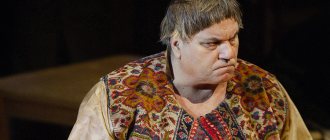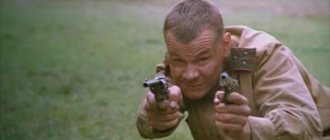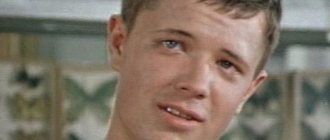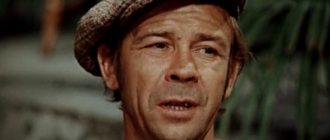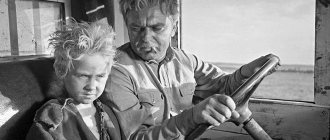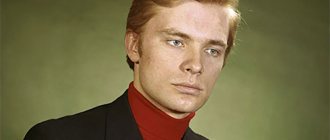Biography
Marlon Brando is a legendary American actor and political activist. Considered one of the most significant actors in the history of cinema. Over more than 50 years of his career, he starred in 40 films, many of which ended up in the golden fund of world cinema. Brando is a two-time Oscar winner, a two-time Golden Globe winner, and an Emmy and Cannes Film Festival winner.
Marlon Brando was born in Omaha, Nebraska. His father, Marlon Brando Sr., owned his own production facility, which produced food for farm and pet animals. Dorothy Pennybaker's mother played in the local theater and was close to actor Henry Fonda. Marlon, who was called Bud as a child, was the youngest child in the family. He had older sisters Jocelyn and Frances.
Marlon Brando in his youth
Brando Sr. was a rather reserved and tough person. He raised his children with extreme severity; they were forbidden to do almost everything, including the outward manifestation of emotions. For example, hugging each other in a family was allowed only on a birthday. The only entertainment in the house was the piano, which Dorothy sometimes played and sang on.
When Marlon was 6 years old, the family moved to the suburbs of Chicago, where Bud went to the fashionable Lincoln School. Until the age of 11, he had no friends, but then he met Wally Cox, who would later also become a famous actor, and from him he became infected with the dream of cinema.
A few years later, Brando’s parents temporarily decided to live separately, and Dorothy and the children moved to her mother in the Californian town of Santa Ana. Brando Jr. began to show himself well as an athlete at his new school and set several local records in athleticism. In addition, he showed himself to be a rebel: he dressed very flashily and brightly, had conflicts with teachers and the director, and had defiant behavior. In high school, Marlon actively played in school plays, mainly dramatic heroes or villains. He wasn't good at comedy roles at all. The young man was also a drummer in a local band.
Actor Marlon Brando
After school, against his own wishes and at the strict insistence of his father, Marlon Brando becomes a cadet at the Shattuck Sainte-Marie military school. There he discovers an amazing ability to imitate other people’s voices, plays Tutankhamun in the school production of “The Message from Hafu” and not only receives a storm of applause from the audience, but also with his performance convinces professor of English language and literature Earl Wagner that his place is on the stage, and not on battlefield. Shocked by the young man's talent, Wagner convinces Brando's parents to allow their son to start an acting career.
Desire for loneliness
1962—1972
Wandering naked along the shore of his own blue lagoon, he was completely happy. At night I sat on the shore, watching as the edge of the ocean began to brighten, announcing the coming of a new day. I spent hours watching the movement of black ants on the white sand of a deserted beach.
At the first sign, Tarita silently appeared nearby, white-toothed, dark-skinned, lay down on the hot sand and reached out to her master as to the sun. He was so accustomed to her silence and consent that he thought out loud in front of her, without hesitation, as in the company of a faithful dog.
Tarita bore him two children - a son, Teota, and a daughter, Sheen. Brando was a strict father; he did not want his children and wife to be spoiled by civilization, and forbade them to leave beyond Tahiti. He himself left them whenever he wanted or for the sake of money, agreeing to filming. So he played Don Corleone in the film “The Godfather,” which created a sensation. Even the bosses of the Italian mafia approved of the image of the Don, saying that Brando played “with dignity.”
He became "Best Actor of the Year". But instead of him, a young Indian woman, Little Feather, came to receive the award and said that the actor was refusing the Oscar in protest against the infringement of the rights of the indigenous population of America... It was a political scandal, one of his many eccentric antics. But the worst thing was that Tarita immediately realized that the Indian woman had not escaped her husband’s bed. His “dog” suddenly turned out to be jealous. Divorce, according to the custom of her people, is accomplished as simply as marriage. Tarita no longer wanted to consider Brando her husband and left with her children for Tahiti, making his island truly uninhabited...
- Welcome to my brothel! - he met directors and producers who came with business proposals...
Then Marlon bought a mansion on Mulholland Drive not far from the house of his friend Jack Nicholson and named it “Fragipani” after the name of a wonderful Tahitian flower. It turned out that loneliness is beautiful only when there is someone to tell about how beautiful loneliness is. There always had to be women next to him - servants, secretaries, nannies of his many children. Only in the presence of the weaker sex did he feel full of strength. And if a woman appeared nearby, Brando, by nature, could not help but sleep with her. Everything must be under control, everything must bear his owner’s mark, and only he can dispose of his territory.
- Welcome to my brothel! - he met directors and producers who came with business proposals, and hospitably pointed out the women scurrying around the house - all of them stately beauties. - You can choose any...
It’s unlikely that anyone agreed to this: Marlon’s words never meant exactly what he said, but try snatching a piece of prey from a lion. Besides, it was impossible to compete with him, and what man wants to feel like a pathetic substitute?
Every day a lot of people sat at the table, many did not know each other. Sometimes children were added: Brando was forced to recognize some, and took others away from their mother. For his eldest son, he sued his first wife for a long time, until finally Christian was given full custody. Mistresses, eccentric friends, half-brothers and sisters, a stern father prone to mood swings... “A gang of schizophrenics,” the son contemptuously called Brando’s entourage and did everything to infuriate his father. Many blamed Marlon for what happened to Christian and Sheen, Brando's daughter from Tahitian Tarita.
Movies
Marlon Brando starred in a large number of films over the 50 years that his career spanned. From the very beginning he was a staunch supporter of Stanislavsky's system, and in his work adhered to the principles of his methodology. Subsequently, Marlon Brando's performance began to be considered a standard, a model to which not only students of theater and film universities, but also famous actors are compared.
Marlon Brando in the film A Streetcar Named Desire
Already the first film “Men” brought the aspiring actor rave reviews from critics and the Finnish film award “Jussi” as the best foreign performer. But real success came a year later, when the film adaptation of Tennessee Williams' classic play A Streetcar Named Desire was released, where Brando's partner was the famous actress Vivien Leigh. The film has become a classic of cinema and is constantly included in lists of the best films in the world. Thanks to this film, Marlon Brando's star rose, but for Vivien Leigh it became, on the contrary, tragic. After participating in the filming of the film, the actress developed manic-depressive psychosis.
For his participation in A Streetcar Named Desire, Brando was nominated for an Oscar, but then he did not receive the statuette. But in 1954, he nevertheless won an Oscar as best actor for his role as former boxer Terry Malloy in the crime drama about corruption On the Waterfront. There are several interesting incidents associated with the film. The main role was to be played by Frank Sinatra, who was personally invited by the director of the film. A contract was even signed with him, but producer Sam Spiegel wanted to see Brando exclusively in this role. He persuaded the increasingly popular actor to take part in the film and, despite legal proceedings with Frank Sinatra, who demanded a penalty for terminating the contract, he approved him in the leading role.
Marlon Brando and Karl Malden in the film On the Waterfront
Another curious fact is that “On the Port” was received rather coolly by the public the year it was released, despite the awards it received. But today the film, shot in just 36 days, is one of the hundred best films of the 20th century.
A notable year in Marlon Brando's acting career is 1972. Then he starred in two films – the gangster drama “The Godfather” and the erotic melodrama “Last Tango in Paris.” It is interesting that the film company that filmed “The Godfather” put forward a demand that Marlon Brando not participate in the film, since the producers had heard about his provocative behavior on film sets. But not a single actor who participated in the auditions was able to show the level of acting that Marlon demonstrated, and as a result, he was approved for the role of the head of the mafia clan Don Vito Corleone. During filming, Brando used a boxing mouthguard to give his jaw an aggressive shape.
In the film “Last Tango in Paris” the famous actor constantly improvised. Most of his lines heard in the final version of the melodrama are absent from the original script. Despite his great creative investment, Brando, like his partner Maria Schneider, was dissatisfied with the work in this film and, after filming, refused to communicate with director Bernardo Bertolucci for about 15 years.
However, the actor was again nominated for an Oscar for his participation in both films, but won the award with The Godfather. Unexpectedly for everyone, he refused to receive the prize and sent Sasha Light Feather, a girl of Indian origin from the Apache family, to the stage in his place, who also did not accept the award. With this act, Marlon Brando drew public attention to discrimination against the indigenous population of America.
Savage
Brando always remembered his first role with special feeling. And this is understandable if you imagine that he had to play no less than Jesus Christ. Brando’s stage debut took place in 1944 while studying at the drama workshop at the New School for Social Research, where, under the guidance of teacher Stella Adler, he studied the then fashionable “Stanislavsky method.” “I could never imagine what emotions a person must experience who not only knows his fate, but also knows exactly where and how he will die,” Brando said. However, it was not the role of the Savior that became the ticket to Olympus for the novice actor. He was first noticed in the Broadway production of “I Remember, Mom,” which ran successfully for two years. But Brando's real fame came in 1947 after the play A Streetcar Named Desire, directed by Elia Kazan. Kazan later directed a film of the same name, in which Brando also played the main role.
Maria Cruz at the Oscars
Lenta.ru
Around this period, the actor joined the American League for the Liberation of Palestine and became a sponsor of various radical Jewish organizations that fought for the creation of an independent state. This was, perhaps, the first manifestation of his peculiar “spontaneous” sense of justice, which later provoked the dramatic events of March 1973.
Brando tried his hand at cinema in 1950, playing in Fred Zinnemann's film "Men." And already in 1952 he received the main prize at the Cannes Film Festival for Best Actor in the film “Viva Zapata!” In ’53, the British Academy of Film presented him with an award for best foreign actor, in ’54, Brando received a Golden Globe, and in ’55, he won his first Oscar for his role as Terry Malloy in the film “On the Waterfront” and at the same time became the idol of the whole. generations. His image of a street savage, flouting established orders and rules, will long become the object of countless imitations. In 1961, he made his own film, “One-Eyed Jacks,” which was not accepted by either viewers or critics. Brando's biographers believe that this particular picture marked the beginning of a ten-year period of failures, when the actor starred in films whose names are difficult for even experts to remember today.
My mother didn't care much about us - she was more concerned about getting a good hard time. And my father seemed to be all alcohol, testosterone, adrenaline and anger. It was more expensive to talk to him about anything.
Marlon Brando
Personal life
Marlon Brando was known as the conqueror of women's hearts. He had a large number of fleeting star romances, including a close relationship with film star Marilyn Monroe.
Marilyn Monroe and Marlon Brando
Officially, he was married three times. In 1957, Marlon married Indian actress Anne Kashfi, who gave birth to his son Christian Devi. In 1959, the couple divorced, and a year later Brando married for the second time to the Mexican actress Movita Castaneda, who was 7 years older than him. This family also lasted only 2 years, but Movita managed to give birth to a son, Miko Castanedo, and in 1966, already out of wedlock, a daughter, Rebecca, was born from Marlon.
Immediately after the second divorce, Brando married 20-year-old Tahitian actress Tarita Teripia, 18 years his junior. They had a son, Simon Teihotu, and a daughter, Tarita Cheney. The actor also adopted the child of his wife Maimiti. This marriage turned out to be the longest of all. They divorced only 10 years later.
Marlon Brando and Tarita Teripia
Marlon Brando never married again, but had a serious relationship with his housekeeper Maria Cristina Ruiz, who gave birth to three children from him: Nina Priscilla, Miles Jonathan and Timothy Gahan. In addition, the actor had several other children out of wedlock. Officially, he recognized 14 children, not counting adopted ones.
Death
In the 90s, Marlon Brando gained weight due to stage 2 diabetes; his weight was about 135 kg. In addition, he began to suffer from memory loss and had vision problems. He was also later diagnosed with liver cancer.
Son Miko, who worked as a security guard for Michael Jackson and who had a friendly relationship with Brando, often brought his father to the Neverland Ranch, where the actor could spend a long time in the open air, as he began to experience oxygen deficiency.
Marlon Brando
A week before his death, the actor received an offer from Tunisian director Reed Behi to work on the script for the new project “Brando and Brando.” But on July 1, 2004, Marlon Brando was admitted to the Ronald Reagan Medical Center in Los Angeles with a diagnosis of pulmonary fibrosis. He refused the offer to insert tubes into his lungs, which was the only way to prolong his life, and died that same day.
Marlon Brando was cremated, and his ashes, combined with those of childhood friend Wally Cox, whose funeral urn the actor had kept in his home since 1973, were scattered over the island of Tahiti and over Death Valley in California.
Godfather
In 1971, when most Hollywood producers put an end to the career of “this savage,” Brando learned about the upcoming filming of the film “The Godfather” based on the novel by Mario Puzo. He himself called director Francis Ford Coppola and proposed his candidacy for the role of Vito Corleone, saying that he could make this image “truly come to life.” The Paramount bosses were categorically against Brando's participation in the film, fearing that the public had already fairly forgotten the hermit and that this ignoramus, who could not even learn the text to the end, was not capable of playing the boss of the Italian mafia. Coppola had to use a trick. He suggested that Marlon Brando come up with an image for himself and film several tests on his own on a home video camera, which the actor did. Well, then the situation becomes almost anecdotal. Coppola presents the footage to the producers, and during the viewing process one of them jumps up and shouts: “Here, this is exactly the one we need. A true Sicilian. By the way, who is he and why haven’t we seen him before?”
Marlon Brando in Vito Corleone makeup
Lenta.ru
What happened after the film's release cannot be called a success. It was something more. It's not even about the extremely successful release of the film, which collected more than $130 million in US theaters alone, and not about every conceivable award that it was awarded. Marlon Brando managed to create a brand that is still an absolute standard for all actors who embody on screen the images of “godfathers” of all stripes. Moreover, as Coppola himself later claimed, the real heads of the largest mafia clans began to copy the habits and manners of Brando’s hero: a bulldog jaw, a hoarse, barely audible voice, special facial expressions and gestures. Often, when talking about certain movie roles, one can imagine how they would look if played by another actor. Such reasoning loses all meaning when it comes to Vito Corleone.
In 1973, after his demarche at the Oscars, Marlon Brando went to Europe, where he starred with Bertolucci in Last Tango in Paris. This picture will be Brando's last significant film work.
Marlon Brando in the movie "Apocalypse Now"
Lenta.ru
In 1979, the same Coppola invited Brando to play a cameo role in the film “Apocalypse Now,” after which the actor finally secluded himself on his island, where he built a research laboratory to study wind and solar energy. In the 90s, Brando starred in several low-budget films, in one of which (“Don Juan De Marco”) he met Johnny Depp on the set. According to the testimony of participants in the filming process, this film became a symbolic passing of the baton “from one great savage to another.” In 2001, Brando made his last appearance on screen in the film “Bugbear,” where he played opposite Robert De Niro, who once played the role of young Corleone in the second episode of “The Godfather.”


